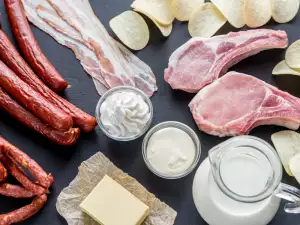Fourme d'Ambert is a worthy competitor to gorgonzola, stilton and Danish blue cheese.
The name of this cheese comes from the small town of Ambert, located on the slopes of the Forez mountain ranges. Fourme d'Ambert is a cheese from cow's milk. It is covered with a thin dry crust, gray or reddish in color. It is easily distinguished by a shape that is quite unusual compared to other types of cheese and is a cylinder weighing about 2 kg, 19-20 cm high and 13 cm in diameter. It is considered one of the most delicate blue cheeses.
The word fourme, like the French word fromage (cheese) itself, comes from the word forme (form), which denotes a cylindrical shape. Whether it's true or not, the people of Auvergne claim that Fourme d'Ambert cheese has existed since the time of the Roman Empire, which gradually conquered Gaul.
Over the centuries Fourme d'Ambert has been produced exclusively in rural farms. Mature cheese was sold in local markets. The triumph of this type of cheese was on May 9, 1972, when Fourme d'Ambert /de Montbrison/ received its first quality certificate.
The first operation for the preparation of this cheese is carried out in a large vessel where the milk is strained. The quality of the future cheese already largely depends on this stage. The milk is heated to 32°C.
Penicillin is added to it to form mold and rennet is used for curdling. The boiled mass is then crushed and kneaded for more than an hour (to separate the whey).
The second stage of preparation is the arrangement of the boiled mass in molds. When kneading the curd, each grain is covered with a thin film. This film prevents the grains from sticking together during the layout in the molds. Noble mold will form in the resulting cavities.

The third step is to remove the serum. The molds with boiled mass are placed in a warmer room for a day, during which they are turned several times. This way, the serum is drained. The future cheese takes its final, cylindrical shape and weight (about 2 kg).
The fourth stage is the salting of the cheese. It is either manually sprinkled with fine salt or immersed in brine for several hours. After salting, the cheese should stay for two days in a well-ventilated room to "rest".
The fifth stage is piercing the cheese with thick, long needles. This way, ventilation passages are made, since mold requires oxygen for its development. Thanks to these movements, the mold will develop normally during the ripening of the cheese. This operation can now be mechanized.
Finally, the last step is maturation process. It takes place in a cool room. The first mold appears after a few days. In order for Fourm d'Ambert to acquire a characteristic delicate taste and aroma, it needs at least 28 days. Statistical studies show that approximately 20% of French families regularly consume Fourme d'Ambert.
This cheese is considered one of the tastiest among French cheeses, although it is cheaper than Roquefort cheese. French food experts recommend it even for children. In the region of the Forez mountains, the climate is quite continental, summers are very hot, but winters can be long and cold (by French standards, of course). The cows graze at an altitude of 600 to 1, 600 meters above sea level. The mountain air and abundant vegetation on the mountain slopes ensure excellent milk quality.
Fat content in Fourme d'Ambert is around 28-29%.
Energy value - 330-370 kcal / 100 grams.

The color of Fourme d'Ambert is pale, slightly creamy. The greenish-bluish mold nests are more or less evenly distributed over the cheese. The thin, natural crust is usually covered with a small amount of fluffy, whitish mold.
The consistency of Fourme d'Ambert is thick, it cannot be called very soft, but at the same time it is delicate, slightly greasy.
The aroma of Fourme d'Ambert cheese is soft, slightly spicy. The taste is not very complex and not very harsh, but well balanced. Salinity is moderate but can be above average.
Wine connoisseurs can enjoy the cheese with Sauternes and other dessert wines, as well as full-bodied reds such as Rhône, Pinot Noir and Syrah. Try the cheese with bread and fruit, or crumble it over green salads and into platters.




















Comments